This tour recommendation leads you along the scenic riverside road from
Osinów Dolny (Niederwutzen) to
Gozdowice (Güstebiese) between the
Odra river and the nature reserve
Odra valley.
Coming from Germany we cross the border in
Osinów Dolny (Niederwutzen), let the so called "Oder Center Berlin", a big shopping
market lie on the left. Of course, whoever wants can fill the tank of his car or visit the market here.
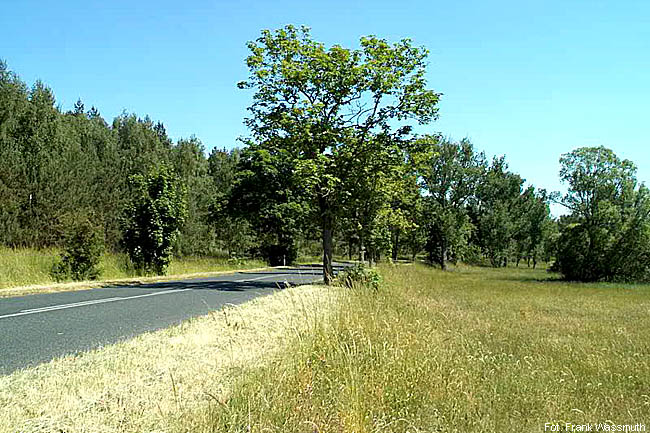
Street scene at the
Odra
Immediately after passing the center at a road junction turn right towards
Dębno (Neudamm/Nm.).
Whom the deciphering of the Polish label is to complicated, look at the sign with the ferry.
From here leads us a little, but in reasonably good condition located coastal road in the southerly direction.
Do not drive so fast, so you can enjoy the magnificent views over
Odra river, which is on the right side of the street.
Storks, the outlet areas of the
Odra , a sight, as it is known from the Danube delta on the Black Sea only.
The trip passes through many small villages which still waiting on their awakening from the slumber, where they seems to be since the
war. But do not worry: the beginning tourism here is showing the first results and some residents think about the
opening of a guesthouse or a restaurant (the first construction works are underway). It would been inconceivable, if they would'nt
do this: the end of the border controls predestine the area for a day trip from near Berlin and surrounding areas.

Beautiful places ...
Several very beautiful parking spaces along the route offers opportunities for rest and picnic.
Before the village Siekierki is a monument and a war graves cemetery. A polish
tank of russian type IS-2 is a reminiscence of the fights, which took place here in the 2nd World War.
The cemetery contains the graves of about 2000 polish soldiers. The monument at the cemetery is a
work of polish sculptor Slavomir Lewinski, who made also the monument on the square in
Mieszkowice (Bärwalde/Nm.).
Right at the tank memorial is a small military museum.
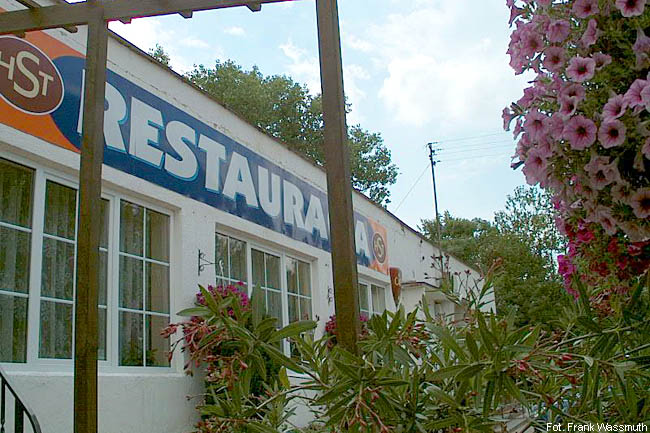
Restaurant "Nad Odrą"
The road leads us further to
Stare Łysogórki (Alt-Lietzegöricke), where you should make a stop in the middle of the village for a meal in the restaurant "Nad Odrą" (flat building with a large sign "Restauracja").
The building including interior has the charm of the early seventies, but the food is really worth a recommendation.
The family-lead restaurant provides fresh preparation and perfect rural cuisine and at numerous visits we were never disappointed about the quality of the meals.
The prices are cheap, how usually in the most polish rural restaurants. If you speak german, you can use a german menu card. Paying with Euro is possible.
In
Stare Łysogórki you will find also a guesthouse of the polish category "Agroturyst" (comparable with "holiday on the farm").
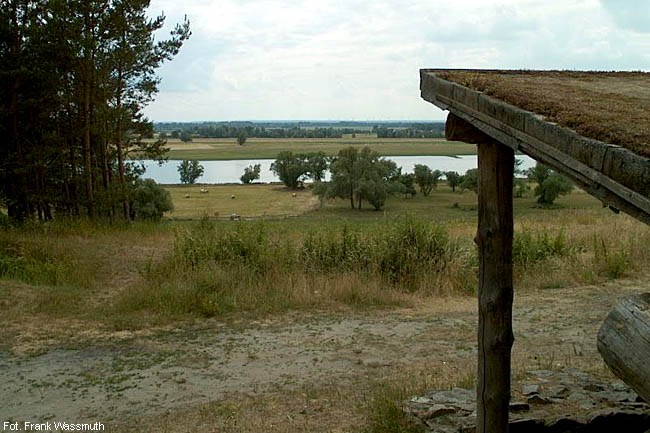
Viewpoint "Bunker"
Shortly before the village
Gozdowice (Güstebiese) should be the next stop at the parking place on the right side.
Behind of another monument to Polish soldiers of the 2nd World War you should park your car in the forest car park and walk few steps in the direction
Odra river. There you will find on a hilltop a beautiful view point from
which you will have a wide view over the
Odra valley to Germany.
At this point is a bunker too, which can be visited.
From the shelter here the polish and soviet troops was commanded in the 2nd World War, when they crossed the
Odra . The bunker today is a replica.
We now proceed in the southerly direction and stop in the village
Gozdowice (Güstebiese).
Gozdowice, the former Gästebiese played a special role in the draining of the
Odra valley, not far away from here was a new straightened river, the so-called New
Odra created.
During the so called Seven Years War (1758) the prussian king Frederick the Great crossed the
Odra here with his troops with the help of a improvised bridge and could win due this action in the battle of
Zorndorf.
Even during the 2nd World War played here a piece of history and again it was a pontoon bridge across the
Odra ,
which was build by polish and soviet army engineer troops under heavy german bombardment to force the
Odra river.
In the center of the village is another monument to the polish army engineer troops on a hill and one more on the southern
direction on a track down to the
Odra river, called "way of death". The "way of death" was used by the polish and soviet troops to reach the
Odra in 2nd World War.
Because it was under the constant bombardment of the german defenders, the earth here since the war is inked with blood.
Not far away from the monument is a small military museum in which you can see army engineering technology and pontoons, which was used for crossing the
Odra .
The "way of death" down and then right again up the mountain (recommended only for people who are good to walk),
a path leading to a hill on which you can find the ruins of a memorial to Frederick the Great, which was erected here in 1908,
but unfortunately it was destroyed in 1945.
Worth seeing is the - now catholic - Church in the village, very conspicuous because of its blueish color.
Near the church stands a monument to the Lehnschulzen (the former owner of an area) Falckenberg, where you will find now a german-polish
commemorative plaque for the residents of the former village Güstebiese, which were killed as a result of the war, a rare reminder of the former german history of the the region.
A lot of peoples of former Güstebiese came between the fronts of the war in early 1945 because a too late evacuation order or was killed during the following escape or due war crimes.
After the war, moved here as in the other villages that we passed on our journey, polish persons, a lot of them from eastern polish territories,
now part of the former Soviet Union.
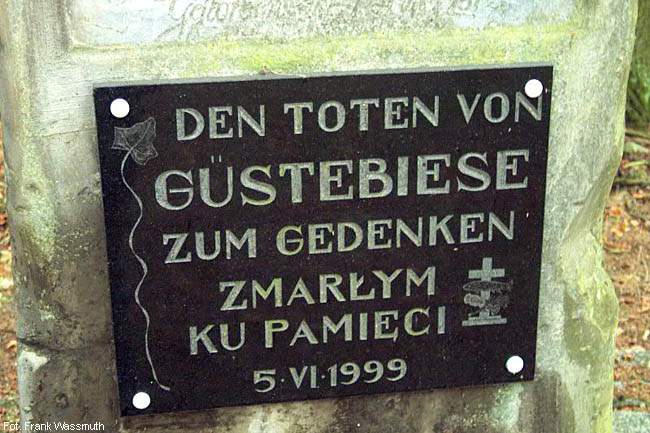
Commemorative plaque near the church
The street down to the
Odra are our last meters of this journey on polish territory.
At the
Odra is the new border crossing point, thanks to Poland's accession to the Schengen agreement it has lost "its job"
and is now a tourist information point (also a public toilet).
Right above there is a small snack bar in the summer with a terrace.
Before the departure its also worth to have a look for the smale shop of the
beekeeping
Atroszko (look for the polish words "Miod" - which is "honey" in english) what offers an excellent honey from its own production.
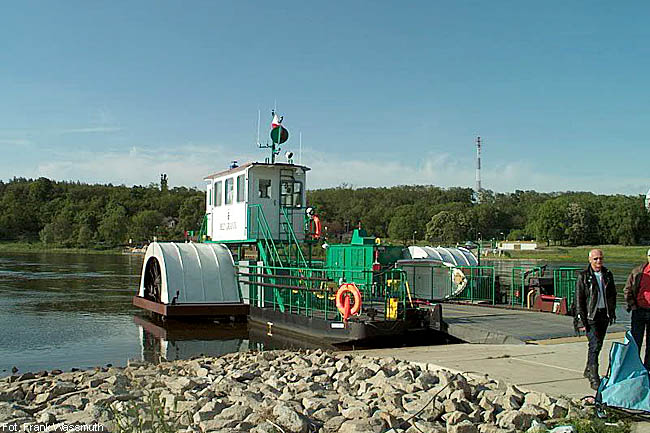
Ferry "Bez Granic"
The trip to Germany is is an attraction itself due the kind of transportation. We cross the river
Odra with a
shovel blade ferry called "Bez Granic" ("Without Borders"), which connects Germany and Poland here since 2007.
The ferry transports cars and vans, smaller trucks or motorhomes over the
Odra to the german village Güstebieser Loose.
Fares are very cheap. Departure times and prices, or the status of the connection can be found on the website
www.gozdowice.pl.
The ferry was already here before the 2nd World War.
In the former Güstebiese there was a well known and higly-frequented hotel called "Deutsches Haus".
Before the war the area was well-known because the beauty of the landscape and the whole territory of the
Neumark was
often used by the Berliners for their trips.
Those who do not wish or can (to expl. because the ferry is not working because the water-level of the
Odra ) to return to
Germany, can instead continue the journey on the land way to $mieszkowiceex or
to cross the german-polish border in $kostrzynex.
F. Wassmuth, Berlin, 2008